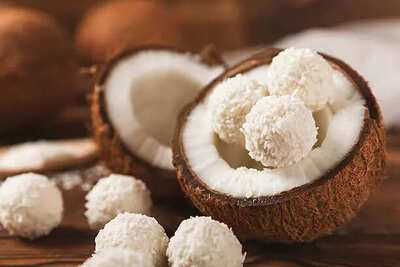Step into any Indian ritual; a temple ceremony, a wedding, even the opening of a shop and chances are you’ll see a coconut. It may sit whole on a brass plate, or be cracked open in one strike, water flowing out like an offering. Across the subcontinent, no other fruit has carried the same weight of meaning. The coconut is more than a ritual object. It is symbol, nourishment, and a link between daily life and the sacred. Scroll down to see why this humble fruit holds such timeless power.
Purity in layers
Part of the coconut’s sanctity lies in its structure. Layer upon layer, the fibrous husk, the hard shell, the pure white kernel , and the sweet water – keep it intact until the moment it is broken. Unlike softer fruits that bruise, the coconut remains sealed and untarnished. That self-contained wholeness gave it an aura of purity. In rituals where cleanliness and sanctity matter deeply, it became nature’s perfect vessel, one that required no human intervention to be “made sacred.”
The meaning of the break

Breaking a coconut has never been just about getting to the fruit inside. According to scriptures, folklore, and regional practices, the act itself carries meaning: the hard shell is seen as the ego or life’s obstacles, while the white kernel inside stands for sincerity and truth. Cracking it open becomes a way of letting go of pride and making room for humility. At weddings, it’s taken as a prayer for harmony; at new beginnings, a gesture of starting fresh. With a single strike, the old is left behind and the path ahead is considered blessed.
Shared across faiths
Unlike many ritual objects tied to one community, the coconut travels widely. In Hindu worship, it is offered to deities before any major step in life. In Kerala’s Christian churches, coconuts are broken during feasts and processions. Sufi shrines in coastal India also accept coconuts as offerings. Few symbols manage this quiet universality. The coconut is one of them – a reminder that devotion often grows out of shared cultural roots rather than rigid boundaries.
Every day becomes sacred

The coconut’s ritual role is also practical. Along India’s coasts, coconut trees were plentiful. The fruit stored well, travelled easily, and was available throughout the year. Beyond rituals, it served as food, drink, lamp oil, and even roofing. Communities that used it every day naturally came to revere it. Over time, what sustained households became central to prayer. Utility evolved into symbolism, and the coconut became both a necessity and an offering.
The tradition today
Modern India still reaches for coconuts at moments of significance. A driver breaks one before taking a new car on the road. A family places it at the threshold of a new home. A film crew might begin a shoot only after cracking one on set. The spaces have changed, but the impulse is the same: beginnings deserve blessing, and the coconut still delivers it.
More than a fruit
The coconut’s enduring role shows how meaning is layered onto the everyday. It is whole and pure, yet also common and practical. It teaches humility in its breaking, abundance in its giving, and continuity in its presence across generations. In a country where rituals adapt constantly, the coconut has remained constant; a small, round reminder that faith often begins with the simplest of things.
3-Ingredient quick nariyal laddu

Ingredients required:
1 cup dessicated coconut (grated desiccated coconut is available in the market)
1 cup condensed milk
1 cup full fat milk
Cardamom powder (optional)
How to make it:
Heat a kadhai and roast the coconut.
Add milk and cook till it is absorbed.
Now add condensed milk and mix well and cook till the mixture is dry.
Sprinkle cardamom powder and shape into laddoos while still hot.
Purity in layers
Part of the coconut’s sanctity lies in its structure. Layer upon layer, the fibrous husk, the hard shell, the pure white kernel , and the sweet water – keep it intact until the moment it is broken. Unlike softer fruits that bruise, the coconut remains sealed and untarnished. That self-contained wholeness gave it an aura of purity. In rituals where cleanliness and sanctity matter deeply, it became nature’s perfect vessel, one that required no human intervention to be “made sacred.”
The meaning of the break
Breaking a coconut has never been just about getting to the fruit inside. According to scriptures, folklore, and regional practices, the act itself carries meaning: the hard shell is seen as the ego or life’s obstacles, while the white kernel inside stands for sincerity and truth. Cracking it open becomes a way of letting go of pride and making room for humility. At weddings, it’s taken as a prayer for harmony; at new beginnings, a gesture of starting fresh. With a single strike, the old is left behind and the path ahead is considered blessed.
Shared across faiths
Unlike many ritual objects tied to one community, the coconut travels widely. In Hindu worship, it is offered to deities before any major step in life. In Kerala’s Christian churches, coconuts are broken during feasts and processions. Sufi shrines in coastal India also accept coconuts as offerings. Few symbols manage this quiet universality. The coconut is one of them – a reminder that devotion often grows out of shared cultural roots rather than rigid boundaries.
Every day becomes sacred

The coconut’s ritual role is also practical. Along India’s coasts, coconut trees were plentiful. The fruit stored well, travelled easily, and was available throughout the year. Beyond rituals, it served as food, drink, lamp oil, and even roofing. Communities that used it every day naturally came to revere it. Over time, what sustained households became central to prayer. Utility evolved into symbolism, and the coconut became both a necessity and an offering.
The tradition today
Modern India still reaches for coconuts at moments of significance. A driver breaks one before taking a new car on the road. A family places it at the threshold of a new home. A film crew might begin a shoot only after cracking one on set. The spaces have changed, but the impulse is the same: beginnings deserve blessing, and the coconut still delivers it.
More than a fruit
The coconut’s enduring role shows how meaning is layered onto the everyday. It is whole and pure, yet also common and practical. It teaches humility in its breaking, abundance in its giving, and continuity in its presence across generations. In a country where rituals adapt constantly, the coconut has remained constant; a small, round reminder that faith often begins with the simplest of things.
3-Ingredient quick nariyal laddu
Ingredients required:
1 cup dessicated coconut (grated desiccated coconut is available in the market)
1 cup condensed milk
1 cup full fat milk
Cardamom powder (optional)
How to make it:
Heat a kadhai and roast the coconut.
Add milk and cook till it is absorbed.
Now add condensed milk and mix well and cook till the mixture is dry.
Sprinkle cardamom powder and shape into laddoos while still hot.
You may also like

India sets up National Designated Authority to implement provisions of carbon trading under Paris Agreement

Punjab govt mounts massive flood relief operation, ministers deployed in affected districts

Bihar: Governor Arif Mohammed Khan celebrates Ganesh Chaturthi, visits pandal

DPL 2025: Virender Sehwag's Son Aryavir Sehwag Fearlessly Hits Boundaries Against Navdeep Saini On Debut; Video

Two flights to Shivamogga diverted to Hyderabad due to bad weather





